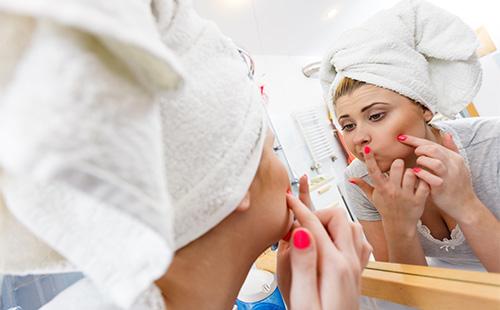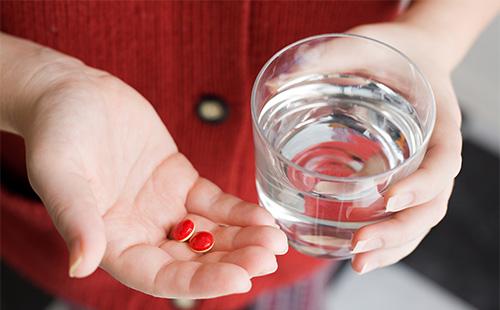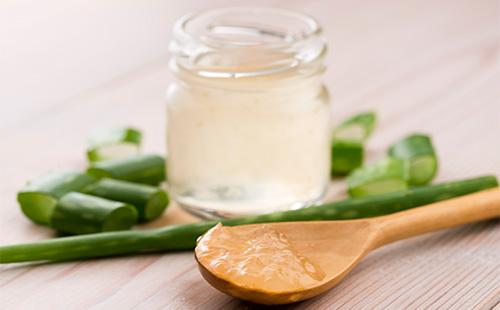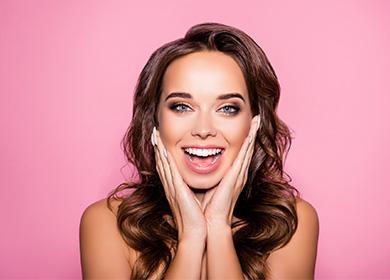The content of the article
Rosacea on the face looks like bright scarlet acne at different stages of maturation. They are located on top of the skin area occupied by the capillary "mesh". The disease inevitably affects the cheekbones, can also affect the chin, forehead and nose. It represents a pathology of blood vessels rather than skin. The treatment for rosacea on the face may be the same as for conventional acne. But the best way to get rid of it is to identify and limit the factor to which they react so painfully.
Causes of the appearance and occurrence of rosacea on the face
Rosacea on the face appears most often in men as a result of pathological changes in the arterioles - the vessels-precursors of the capillaries, with the spread to the adjacent pores and sebaceous glands. The changes are the loss of elasticity by their walls, which leads to their irreversible expansion together with the capillaries themselves. Outwardly, this is manifested rosacea (telangiectasias) - a reddish vascular "net" that disappears briefly with pressure, and erythema of the face (persistent redness and rashes). Most often among the causes of rosacea in dermatology, the following are mentioned.
- Age. Over the years, vessels of any diameter in the human body lose their flexibility, become full of blood, undergo stretching, clogging with cholesterol plaques, and thrombosis. Capillaries are less susceptible to atherosclerosis than the main arteries, but they expand more noticeably under the influence of external factors. The first "mesh" usually appears on the wings of the nose, gradually spreading to the entire back of the nose and its tip. Over the years, redness in the area of the cheekbones and chin is added, less often - the forehead.
- Genetics. Heredity sets many parameters of the structure and functioning of blood vessels. Their too "pretentious" form in the area supplying blood to the brain leads to the development of migraine. It strongly depends on genes and aneurysm - a deadly phenomenon in which one of the sections of the vessel lacks nerve endings, it is immobilized and therefore gradually stretches under the pressure of the blood, forming a bag filled with it. Sooner or later, the aneurysm bursts. If its breakthrough leads to hemorrhage in the brain and other vital organs, death occurs. The situation is similar with capillaries. Their early rejection is most often associated with adverse heredity in combination with other provoking factors. The prevailing point of view now is that light-skinned, fair-haired and fair-eyed patients are more prone to rosacea - persons with a “Nordic” type of appearance.
- Frequent skin heating. Capillaries can be stimulated to expand by taking sun baths and sunbathing in a solarium, using warming masks, steaming the face, rubbing it with alcohol, and abusing alcohol (ethanol accelerates blood flow several times). Passion for such procedures makes couperosis and rosacea appear brighter and faster.
- Blood clotting disorders. Diseases of the liver, taking anticoagulants make blood thinner. This improves capillary circulation and at the same time accelerates the development of telangiectasias. Progressive cirrhosis in combination with the "magical" effect of ethanol is clearly visible in alcoholics on the red tip of the nose and cheekbones from rosacea.
- Hormonal disruption. Hormones are one of the main agents by which the brain regulates the functioning of the heart and blood vessels. Changes in their proportion and concentration are one of the main causes of aging of the vascular network. Their effect on atherosclerosis and age-related slowdown in the synthesis of collagen and elastin, proteins that support the elasticity of all tissues, is also great. Most often, background fluctuations are caused by pathologies of the endocrine glands, menopause, intake or topical application of hormonal agents (contraceptives, corticosteroids). Hormonal rosacea and steroid rosacea on the face are more common in women. The natural cycle is typical for them throughout the childbearing period, one or several pregnancies take place, over the years many of them resort to hormonal cosmetics to improve the appearance of the skin. And hormonal diseases are equally common in both sexes.
- Traumatic effects. Especially age-related and hardware cosmetology - laser resurfacing, chemical peeling, mesotherapy.
Additional factors of influence
Developed rosacea also usually exists on its own and does not lead to the appearance of rosacea. The only explanation for the “irregularity” of the manifestations of rosacea in predisposed patients is that for the development of pathology there are few acute reactions from the vessels. Additional influencing factors are required, such as:
- immune - reduced local or general immunity;
- diseases of other organs - or systems that result in decreased immunity (diabetes mellitus);
- infectious - the presence of the bacterium Helicobacter pylori in the microflora of the stomach;
- parasitic - the presence of a skin tick Demodex.
Demodex mite activity was previously thought to be the main cause of rosacea. Now it is known for certain that it easily integrates into the normal microflora of the skin and does not cause not only rosacea, but also demodecosis in most infected people. Gastroenterologists also have claims to the version about the relationship between rosacea and the presence of Helicobacter in the mucus layer on the walls of the stomach or intestinal dysbiosis.
The indicated bacterium is considered carcinogenic since its activity provokes inflammation and ulceration of the mucous membrane of the digestive organs. Chronic inflammatory process leads to malignancy - malignant degeneration. The relationship between Helicobacter pylori and rosacea is visible only in statistics. According to them, in patients suffering from pink acne, the bacterium is detected several times more often than in healthy ones.
The pattern may be associated with reflex acceleration of blood flow and the expansion of all blood vessels, not only after eating, but also with its difficult, protracted digestion. This is characteristic of all pathologies of the digestive system. Gastroenterology remarks in response that the train of thought is correct: the face of a satiated person turns red after eating and remains so for the next hour. But there are many diseases of the digestive system, many of them are not connected with Helicobacter, and for some reason they do not cause rosacea. This means that the statistics underlying this theory are one-sided and do not take into account all available combinations.

Signs
The disease begins with persistent redness of the skin on the most protruding parts of the face - the forehead, cheekbones, chin, and back of the nose. Then bright scarlet pimples form on a constantly reddish background. Further symptoms of rosacea on the face resemble acne, manifesting:
- mild soreness - when touching the foci of inflammation;
- feeling of heaviness, burning and throbbing - if the process has spread to the subcutaneous tissue and threatens the appearance of a boil;
- peeling - around inflamed pores and over the entire surface of the skin occupied by rosacea;
- the formation of "heads" - usually not purulent.
In combination with a skin infection, including an imbalance of microflora, ulcers can contain pathogens or an admixture of blood.
After several years of alternating intensified rashes with periods of relative calm, the skin in their place becomes denser, finally acquiring a tuberous structure. In about half of patients, exacerbations of rosacea are accompanied by redness of the eyes, lacrimation, a feeling of a foreign object during blinking, and photophobia.
According to modern doctors, the symptom of rosacea most of all depends not on the development of rosacea, but on a factor complicating it. "Eye" complications (swollen eyelids, conjunctivitis), itching in the eyelids and the entire affected area are usually due to increased activity of the demodex tick. And with reduced immunity, which always makes bacteria on the skin more aggressive, rosacea tends to merge into large nodes, spread to the subcutaneous tissue with the formation of edema and foci of infiltration.
Kinds
The following forms of rosacea are most common.
- Papular nodosum. Science has not yet decided whether it is a late complication of rosacea, more characteristic of male skin, or one of the options for the course of pathology. But the papular-nodular form (it is also often called phimatous) leads to the growth of connective tissue around the often inflamed sebaceous glands, which leads to the appearance of subcutaneous hard nodules.
- Papulopustular. It is most similar in appearance to acne and manifests itself in multiple acne at different stages of "maturation", filled with lymph (more often) or pus (less often). Many of the blackheads formed during it contain or leave behind typical black or white comedones - fat “plugs” in the ducts of the sebaceous glands.
- Erythematous. With it, the skin not only turns red, but also rapidly “overgrows” with areas of rosacea, especially at the end of an exacerbation. Therefore, it is also called erythematous-telangiectatic.
- Eye. It is observed in no more than half the cases of rosacea. With an ocular form, skin rashes in patients are always accompanied by changes in the ocular vessels and inflammatory processes in them, the conjunctiva, and eyelid tissues. Symptoms of only the skin or eyes separately do not appear.
Therapy and Prevention
It is difficult to treat rosacea on the face, since the causes of this phenomenon are not completely clear. From the point of view of official medicine, getting rid of rosacea in the simplest cases can also be done by avoiding irritating effects on the skin. If specific “triggers” (factors that trigger the entire cascade of reactions) are detected, they must also be excluded from everyday life.

Medication
If there is secondary suppuration or the origins of the disease cannot be established, the following drugs are indicated.
- "Metronidazole." As a consequence of the "helicobacter" theory of rosacea. Like any antibiotic, Metronidazole helps prevent papules from overgrowing with local microflora and suppuration. It is usually used internally when trichomoniasis, but on its basis there is also a cream from rosacea on the face, intended for local applications.
- Ivermectin. Anthelmintic and antiparasitic agent used orally for rosacea. Helminthic invasions often provoke a skin rash, since these parasites secrete waste products with a neurotoxic effect into the intestinal cavity and blood. Immunity does not have effective mechanisms for influencing helminths or their larvae. But he indirectly reacts to the appearance of the poisons they secreted in the blood, which can be manifested by fever, fever, sore throat, migraine, rash similar to hives. Some of this is similar to rosacea, presumably can enhance the brightness of the manifestations of the pathology or cause it.
- Tetracycline antibiotics. For example, "Doxycycline". They are versatile enough to prevent secondary infections and not strong enough to destroy all normal microflora of the skin. Tetracyclines also inhibit the reproduction of the Demodex tick.
- Macrolides. Erythromycin, Clarithromycin. They are illegible and very good at killing all gram-positive bacteria, including components of the normal microflora of the skin that are immune to other antibiotics. Macrolides are useful for active accumulation in tissues, which makes them the best "candidate" in the fight against parasites and intracellular microorganisms - chlamydiaamoeba mycoplasmaTrichomonas.
Aids
Along the way, patients are prescribed general strengthening measures to accelerate skin renewal, normalize the blood vessels supplying it with blood, and strengthen its natural protective barriers. Of these, vitamins, proteins (especially gelatin, since it is rich in collagen) and trace elements besides the expanding capillaries of iodine.
Light bleaching, exfoliating, anti-inflammatory antiseptics in the form of organic acids - ascorbic, are also used. salicylic, azelaic, boric. But they are a double-edged sword, as they have the property of reducing blood coagulability, enhancing the manifestations of rosacea instead of eliminating them.
Disinfect and dry foci of inflammation and sulfur-based products. Their application to irritated skin also has disadvantages. It is fraught with increased redness and unbearable burning.
Diet
Often, if you do not cure rosacea on your face, then you can control the recurrence of the disease using a low-fat diet with strict restrictions on food intake:
- fried;
- smoked;
- fatty (including rich in vegetable and hydrogenated fat);
- hot (including pickled);
- spicy.
This diet also prohibits the use of foods and drinks containing neurostimulants (giving the effect of vivacity) - coffee, tea, mate, ephedrine, guarana extract, cocoa, chocolate. It excludes alcohol completely, regardless of the “degree” (beer and kvass are also prohibited).
Limiting the use of salt and up to half a dessert spoon per day helps to cope with edema with erythema and excessive "swelling" of inflammation.This measure is not required, but it is recommended for the quickest "drying" of blackheads and reduce swelling of the eyelids. You can refuse salt completely, but not for more than a week. A longer salt-free diet has proven that it does much more harm to the water-salt metabolism in the body than to benefits.

Alternative methods
Folk remedies for rosacea are selected to relieve irritation and inflammation, without trying to correct or completely destroy the local microflora, which is a plus whenever its disturbances are not detected and the patient’s general immunity works fine. Face masks with rosacea are used exclusively cold, they are made on the basis of strong (tablespoon per glass of boiling water) decoctions and infusions of anti-inflammatory herbs:
It is also recommended to apply non-stained fresh juice of acidic berries and citrus fruits - mountain ash, lingonberries, cranberries, lemon, grapefruit, as well as homemade apple cider vinegar to the affected area or the entire skin of the face. It must be remembered that they are strong provocateurs of allergies, and in the mechanics of the development of rosacea there is a clear autoimmune “component”.
A slight tingling from their application in the acute stage of irritation is understandable, but the intensification of itching and redness is not. After one such episode, any acid-based products should be discarded, whether they are store cream for problem skin or plant juice.
Reduce irritation and eliminate part of acne by reducing the tightness of skin contact with the environment, sometimes light vegetable fats help - olivecotton or linseed oil high degree of purification. Coarse unrefined fats and castor oil are not allowed on the face.
What can not be done
But masks based on dairy products and sugar sources (sugar itself, honey, starch) are not recommended for rosacea. They are an ideal breeding ground for pathogens of all kinds. The presence of sugar in the mask will increase the rush of blood to the area of its application, since the body will never miss the opportunity to “enjoy” this vital component of food. In addition to sour milk and sweet masks with rosacea, the following is strictly prohibited.
- Wipe your face. It does not matter with alcohol or a decoction of medicinal plants. Facial massage performed in any way, including this one, only accelerates blood circulation in its vessels, enhances the filling of capillaries with blood and causes the growth of their “mesh”. Acne, especially if there is an acute purulent process in them, it also will not benefit, and it will not cause pleasant sensations. All applications for rosacea should be applied without rubbing elements, patting with light movements.
- Warm up the face. Despite the apparent "drying" of the foci of inflammation during heating. It simultaneously enhances blood circulation, leading to the rapid progress of rosacea.
- Sunbathe. In the sun or in the solarium. In the case of ultraviolet, it is not even about warming up, but about radiation.Damaged epidermis passes the dangerous part of solar radiation deeper into the inner layers, which are not adapted to contact with it, which is fraught with the appearance of age spots, destruction of the collagen base of the dermis (premature sagging) and cancer.
- Resort to peeling. Chemical, mechanical, and generally any. Artificial “scraping” of the upper layer of the skin makes it visually younger and smoother. But young horny cells, located under a layer of mature ones, are unable to perform the protective functions inherent in the epidermis in full. Cuperosis often becomes a cause of fascination with peeling at the age of over thirty-five, when the first signs of aging are already becoming noticeable, but are still being eliminated with it.
- Use foundation cream. Not even comedogenic. He, as well as powder, blush cover his face with a dense film, only enhancing the heating of the tissues under it, preventing them from breathing. An exception to this prohibition is cases where rosacea helps the patient by applying vegetable oils and other nutritious bases. The inflammation here is most likely caused by too close contact of the skin with the environment (sun, too cold or hot air). A hypoallergenic and extremely light foundation can replace a fat film for such a patient, at the same time masking the defects of the epidermis.
Also, do not treat rosacea on the face or eliminate the effects of rashes using methods of hardware cosmetology (mesotherapy, resurfacing) and plastic surgery. The only exception to the rule is laser removal of the vascular "mesh". But even in this case, experts recommend stopping on sclerosant injections, cryotherapy and other solutions that do not require heating.

Reviews
Anyone with rosacea! She was tormented and treated by all means for almost 5 years. And only now, pah pah pah, I see the results. I drink doxycycline for ten days. This is a tetracycline antibiotic. Cheap. I don’t know if the improvement is lasting, but it is !!!! I’ll finish the second package and see what happens next without medicine. I wish you all good luck in your treatment and recovery !!!!!
Victoria, http://www.woman.ru/health/medley7/thread/3848155/
Our medicine, especially in dermatology, leaves much to be desired. I had to change my lifestyle and nutrition, and improvements began. So far, only the skin was treated, there was no result. You can type in the search for "rosacea" there will give reasons. I'm still looking for them at home. I was given antibiotics three times in 8 months (Trichopolum) until I had candidiasis of the throat. Now I only use ointment.
Alena1130, http://irecommend.ru/content/rozatsea-demodekoz-na-puti-k-istseleniyu
I wash my face with fruit acid lotion in the morning and apply Bepanten cream, smear face with cream with retinol at night, make chamomile and wipe my skin 2-4 times a day, I don’t want to take antibiotics, because there is no rash, but only redness. I compared the skin in a week and saw a good result, there is no more red face, the color evened out and became pleasant.
Vika, https://cosmetology-info.ru/142/Rozatsea— Effektivnye-metody-lecheniya/

